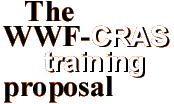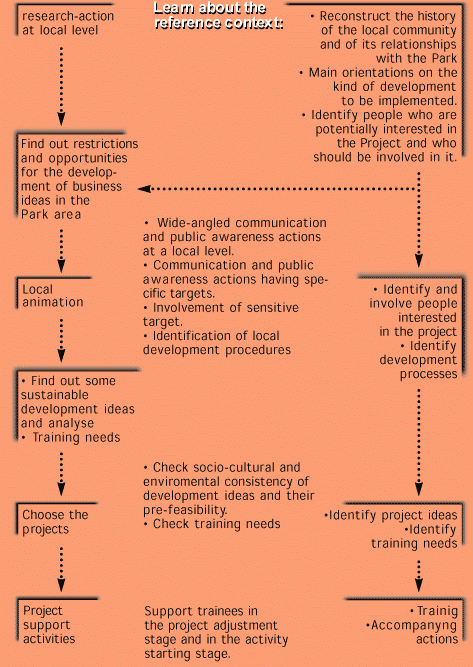|

 he
objectives of the WWF’s ADAPT project: "Park
Areas: the Environment from restriction to development opportunity"
were the promotion of sustainable development
interventions in park areas through the adaptation
and strengthening of the competencies
of those economical operators working in strategic sectors for the
development of these areas. The project involved four national parks
and was divided into two general stages: the first stage aimed at
identifying sustainable development opportunities
in the park areas; the purpose of the second stage was to
put these ideas into practice through training
activities and actions aimed at supporting
local business activities. he
objectives of the WWF’s ADAPT project: "Park
Areas: the Environment from restriction to development opportunity"
were the promotion of sustainable development
interventions in park areas through the adaptation
and strengthening of the competencies
of those economical operators working in strategic sectors for the
development of these areas. The project involved four national parks
and was divided into two general stages: the first stage aimed at
identifying sustainable development opportunities
in the park areas; the purpose of the second stage was to
put these ideas into practice through training
activities and actions aimed at supporting
local business activities.
The project was organized by a central
team, whose function was to coordinate and give a methodological
support to the project’s activities, and some local
teams that had to be a link between the various areas
and the coordinating team, as well as a structure dealing with direct
interventions on the area during research, animation, didactic planning
and training course management stages. Local teams have been the
main partners for local stakeholders and economical operators.
Scheme 1 describes the structure of the various
stages of the project. The aim of research-action
activities was to verify development opportunities of an area through:
a) a desk research which enabled
to outline and define, for each park area, the economical, social,
institutional and legislative reference contexts and the existing
development opportunities;
b) a field research, carried
out by local animators in order to see which are the main orientations
of social stakeholders about the kind of development initiatives
to be taken in those areas, using the interview technique;
c) the comparison between the
results of socio-economical analysis and the orientations that came
out during field investigations. The results of this comparison
showed a first grid of productive sectors, project ideas to be promoted
and supported as well as a list of (institutional, social and economical)
subjects that could be involved in sustainable development initiatives.
Later on, a set of local animation
and public awareness activities
were implemented. These activities aimed at analysing
local productive stakeholders who would benefit from the interventions
and at finding out which users
were interested in taking part in the training intervention. Local
animators also carried out an analysis of the various stakeholders
selected, trying to identify their needs
in terms of development of the productive stakeholders involved
and the need to strengthen single competencies.
These activities (research-intervention and local animation) have
been propaedeutic to the second
stage of the project which is mostly dedicated to training activities.
In this way, it was possible to create
the operational conditions to implement project ideas
in practice, through training support, in a real development initiative.
Moreover, some activities to support trainees
and give assistance for the
realization of project ideas at the end of the training process
were planned.
Training activities were planned and designed according to the indications
that came out from the analysis of the needs expressed by productive
stakeholders involved in the intervention. The result of this process
was a set of training programmes planned in a differentiated manner
and characterized by a structure matching the trainees’
training needs as well as the specific objectives of
training courses.
From the methodological point of view, it is worth mentioning the
importance of work organization both for the central coordinating
team and for the local teams. Local teams played a crucial
role in the implementation of field activities. As a
matter of fact, they took part directly into the local animation
stage, didactic planning and into the management of training courses
as tutors. Moreover, they were in charge of identifying competency
needs of productive structures in every single park area that deserved
to be enhanced. This enabled them to take
an active part into didactic planning and the adjustment
of training processes in agreement with the central team. Didactic
planning followed one single structure for every training
intervention:
- orientation
(balance of competencies, make training needs plain, possible
training programmes, training agreement);
- orientation
towards the context (know the context, meet witnesses, attend
guided visits, find out opportunities and project ideas);
- practical
sessions alternated with theory courses;
- strengthen
and adjust competencies (specific and technical/specialistic
investigations with experts and teachers);
- find
out the ways to carry on with tutoring activities.
|



|
|
Therefore,
didactic programmes were not
previously defined, but they were adjusted step by step by local
teams, in order to come up to the training
needs of participants in relation with the specific training
objectives which have been gradually defined during the training
process.
Training initiatives ended up
with an analysis of the needs in comparison with the kind of supporting
and accompanying actions to be implemented in order to support project
ideas that came out during theoretical sessions and,
later on, for their own implementation. The results obtained (in
terms of products and resources involved) have previously been presented.
Planning of training subjects
- starting from field analysis -, flexible didactic structure -
based on theoretical sessions alternated with practical activities
- and the possibility to benefit from supporting/accompanying actions
represent the innovatory elements
that characterized training courses organized in the framework of
ADAPT Initiative. As a matter of fact, they made the difference
with traditional vocational training which can be implemented in
the framework of the Objectives financed by the European Social
Fund. The results are certainly positive
from various points of view (creation of operator networks, overcoming
of sectorial practices, experimentation of an innovatory approach,
adjustment of a model of intervention, etc.).
Therefore, the experience acquired offers
opportunities to think of the problems related to planning/managing
training interventions and of the opportunities and limits to experiment
innovatory training interventions.
|
|



